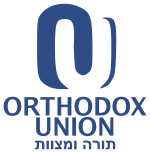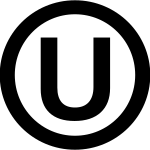Orthodox Union facts for kids
|
תורה ומצוות
|
|

Current logo
|
|
| Abbreviation | OU |
|---|---|
| Formation | 1898 |
| Founder | Henry Pereira Mendes |
| Headquarters | New York City, US |
|
President
|
Mitchel R. Aeder |
|
Chairman
|
Yehuda Neuberger |
| Affiliations | Orthodox Judaism |
|
Formerly called
|
Union of Orthodox Jewish Congregations of America |
The Orthodox Union (or OU) is one of the biggest groups for Orthodox Jewish people in the United States. It started in 1898. The OU helps many synagogues (Jewish places of worship). It also runs programs for young people and supports people with disabilities. The OU has locations in Israel.
A big part of the OU's work is its kosher certification service. This service checks if food follows Jewish dietary laws. You can often see its special "circled-U" symbol, Error using : Input "24CA" is not a hexadecimal value., on food labels. This symbol means the food is "kosher." Synagogues connected to the OU usually follow Modern Orthodox Judaism. This is a way of life that combines Jewish traditions with modern society.
Contents
History of the OU
How the OU Started
The Orthodox Union began in 1898. It was first called the Union of Orthodox Jewish Congregations of America. Rabbi Henry Pereira Mendes helped create it. The first members were mostly modern, educated Orthodox rabbis and leaders. Many of them were linked to the Jewish Theological Seminary (JTS). This school started to support Orthodox Judaism.
Over time, differences grew between the OU and JTS. By the 1950s, "Conservative" and "Modern Orthodox" Judaism became separate movements. Before this, they were more closely connected.
Growing Over the Years
In its early years, the Orthodox Union helped Yeshiva University grow. Yeshiva University became an important school. It trained American rabbis who spoke English and had a university education. These rabbis then led OU synagogues. Some Orthodox rabbis thought the OU was too "modern." So, they formed their own stricter groups.
Still, the idea of a national Orthodox group became popular. The OU soon became known as a main voice for American Orthodox Jews. In 1919, 150 Orthodox congregations joined the OU's national meeting. This included about 50,000 members. The OU became more involved in American Jewish policy after 1924. This was when Rabbi Herbert S. Goldstein became its president.
The OU worked with other Jewish groups. It helped create the Synagogue Council of America. This group included Reform and Conservative Jewish leaders too. The OU also spoke up for important Orthodox practices. For example, it supported the five-day workweek. It also defended the right to kosher slaughter (a way of preparing meat). The OU also helped Jewish soldiers and European Jews in need.
Kosher Food Certification
In the 1920s, the OU started its kashrut (kosher food) division. This made kosher supervision a community service, not just a business. In 1923, H. J. Heinz Company's vegetarian beans were the first product to get OU kosher certification. Heinz wanted to make sure non-Jewish customers were not put off. So, the OU agreed to use a simple "OU" symbol instead of the word "kosher."
A chemist named Abraham Goldstein helped the OU's kosher program. He used his science knowledge to check if products were kosher. Later, Rabbi Alexander S. Rosenberg helped the OU's kosher program become very respected. He and his team set up good standards for modern food production. This made OU-certified kosher products widely available across the US by the 1950s.
By the mid-1930s, the OU's kosher division was strong. It changed how kosher food was supervised. Before, individual rabbis often handled it as a business. The OU wanted to make kosher food more affordable for everyone.
Mid-Century Developments
The OU Women's Branch started in the 1920s. It encouraged women's groups in OU synagogues. These groups supported Jewish education for women and helped Yeshiva University.
In 1939, Leo S. Hilsenrad became the OU's first full-time director. This made the OU's work more efficient. In 1946, Saul Bernstein joined the staff. He started Jewish Life in 1951. This was a popular magazine for Orthodox Jewish people.
After World War II, many leaders of the OU also led Yeshiva University. The OU grew even more after Moses I. Feuerstein became president in 1954. Talented leaders like Joseph Karasick and Harold M. Jacobs helped guide the OU's growth for decades.
In 1959, Rabbi Pinchas Stolper became the director of the OU's youth group. This group is called the National Conference of Synagogue Youth (NCSY). NCSY inspired many Jewish high school students to become more religious. It played a big part in the "baal teshuva" movement. This was a spiritual re-awakening among Jewish youth after the 1967 Six-Day War.
Women have been members of the OU's board of directors since the mid-1970s. By the late 20th century, most OU synagogues had rabbis trained at Yeshiva University. These rabbis followed Modern Orthodox ideas. In recent years, the OU's general approach has become stricter. This reflects a trend in American Orthodoxy towards more traditional practices.
The 21st Century
In 2009, Rabbi Steven Weil became the OU's Executive Vice President. Allen Fagin took over in April 2014. In 2011, Rabbi Simcha Katz became president. Moishe Bane became president in January 2017. In 2014, women were elected as national officers for the first time. Three women became national vice presidents. Two women became associate vice presidents.
In 2017, the OU made it official policy that only men can be clergy (religious leaders). This means women cannot hold titles like "rabbi" in its synagogues in the United States.
In June 2018, a government official spoke at the OU Advocacy Center's meeting. He was given an award for "Justice, justice shalt thou pursue."
In 2020, Rabbi Moshe Hauer became the Executive Vice President. Rabbi Josh Joseph became EVP/COO. Rabbi Hauer handles policy and is the main spokesperson. Rabbi Joseph manages programs and operations, except for the Kashrut division. Rabbi Menachem Genack is the CEO of the Kashrut division. Mitchel Aeder is the current president.
What the OU Does
Working with the Rabbinical Council of America
For many years, the OU and its rabbinic group, the Rabbinical Council of America, worked with other Jewish groups. They were part of the Synagogue Council of America. In this group, Orthodox, Conservative, and Reform groups worked together. They focused on issues that concerned all of them. The group ended in 1994. This was mainly because Orthodox groups disagreed with Reform Judaism's view on defining Jewishness.
Kosher Certification
| Hechsher of the Orthodox Union | |
|---|---|
 |
|
| Expansion | Orthodox Union |
| Certifying agency | Kosher Division of Orthodox Union |
| Product category | Food products |
| Type of standard | Religious |
The Orthodox Union's Kosher Division is the biggest kosher certification group in the world. It is led by CEO Menachem Genack. As of 2023, it checks over 1,200,000 products. These products come from 13,000 factories in 105 countries. About 200,000 of these products are found in the US.
The OU employs 886 rabbis who work in the field. They are called mashgichim in Hebrew. About 70 rabbinic coordinators manage the companies that use OU certification. There are also specialists for ingredients and flavors. The process involves sending a mashgiach to the factory. They make sure the product follows Jewish law. The mashgiach checks both the ingredients and how the food is made.
National Conference of Synagogue Youth
The National Conference of Synagogue Youth (NCSY) is the OU's international youth group. It started in the early 1950s. NCSY became successful under Rabbi Pinchas Stolper. It reached out to Jewish young people who went to public schools. It inspired them to learn more about Orthodox Jewish religion. Now, NCSY also includes many religious children. Most of these children attend Jewish day schools.
Orthodox Union Advocacy Center
The OU Advocacy Center is the OU's public policy group. It works in Washington, D.C. and state capitals. It used to be called the Institute for Public Affairs. The OU Advocacy Center talks with government leaders. It also speaks to the public. Its goal is to support the interests and values of the Orthodox Jewish community.
Synagogue Connections
The OU requires its member synagogues to follow Orthodox Jewish law and traditions. In these synagogues, men and women sit separately. They are almost always separated by a mechitza. This is a physical divider between the men's and women's sections. Many OU synagogues support Religious Zionism. This belief teaches that the country of State of Israel is important for the arrival of the Messiah. It also teaches that all Jews will eventually return to live in their ancient homeland.
The laws of Shabbat (the Sabbath) and kashrut (kosher food) are very important. People pray in Hebrew. They use the same traditional prayer book (siddur) that has been used for centuries. This includes both Ashkenazi and Sephardi Jewish communities.
For many years, the most popular English prayer book in OU synagogues was Ha-Siddur Ha-Shalem. It was edited by Philip Birnbaum. More recently, the Artscroll siddur and the Koren Siddur have become popular. Similarly, the Pentateuch and Haftarahs was a common Hebrew-English Chumash (Torah text). This was edited by Rabbi Joseph H. Hertz. Now, The Chumash: The Stone Edition, also known as the Artscroll Chumash, is more common.
Yachad
Yachad: The National Jewish Council for Disabilities is a global group. It helps Jewish people with disabilities. It works to make sure they are included in all parts of Jewish life. Yachad wants to ensure that people with different abilities have their rightful place in the Jewish community. It also helps teach and advocate for better understanding and acceptance of disabled people in the Jewish world.
See also
 In Spanish: Unión Ortodoxa para niños
In Spanish: Unión Ortodoxa para niños
- Rabbinical Council of America
- COR

